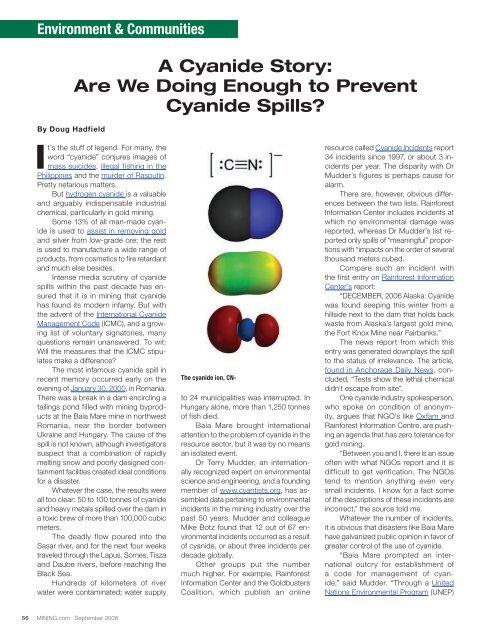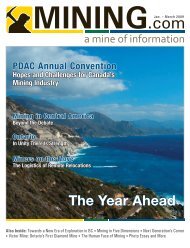You also want an ePaper? Increase the reach of your titles
YUMPU automatically turns print PDFs into web optimized ePapers that Google loves.
Environment & Communities<br />
By Doug Hadfield<br />
It’s the stuff of legend. For many, the<br />
word “cyanide” conjures images of<br />
mass suicides, illegal fishing in the<br />
Philippines and the murder of Rasputin.<br />
Pretty nefarious matters.<br />
But hydrogen cyanide is a valuable<br />
and arguably indispensable industrial<br />
chemical, particularly in gold mining.<br />
Some 13% of all man-made cyanide<br />
is used to assist in removing gold<br />
and silver from low-grade ore; the rest<br />
is used to manufacture a wide range of<br />
products, from cosmetics to fire retardant<br />
and much else besides.<br />
Intense media scrutiny of cyanide<br />
spills within the past decade has ensured<br />
that it is in mining that cyanide<br />
has found its modern infamy. But with<br />
the advent of the International Cyanide<br />
Management Code (ICMC), and a growing<br />
list of voluntary signatories, many<br />
questions remain unanswered. To wit:<br />
Will the measures that the ICMC stipulates<br />
make a difference?<br />
The most infamous cyanide spill in<br />
recent memory occurred early on the<br />
evening of January 30, 2000, in Romania.<br />
There was a break in a dam encircling a<br />
tailings pond filled with mining byproducts<br />
at the Baia Mare mine in northwest<br />
Romania, near the border between<br />
Ukraine and Hungary. The cause of the<br />
spill is not known, although investigators<br />
suspect that a <strong>com</strong>bination of rapidly<br />
melting snow and poorly designed containment<br />
facilities created ideal conditions<br />
for a disaster.<br />
Whatever the case, the results were<br />
all too clear: 50 to 100 tonnes of cyanide<br />
and heavy metals spilled over the dam in<br />
a toxic brew of more than 100,000 cubic<br />
meters.<br />
The deadly flow poured into the<br />
Sasar river, and for the next four weeks<br />
traveled through the Lapus, Somes, Tisza<br />
and Daube rivers, before reaching the<br />
Black Sea.<br />
Hundreds of kilometers of river<br />
water were contaminated; water supply<br />
56 <strong>MINING</strong>.<strong>com</strong> September 2008<br />
A Cyanide Story:<br />
Are We Doing Enough to Prevent<br />
Cyanide Spills?<br />
The cyanide ion, CN-<br />
to 24 municipalities was interrupted. In<br />
Hungary alone, more than 1,250 tonnes<br />
of fish died.<br />
Baia Mare brought international<br />
attention to the problem of cyanide in the<br />
resource sector, but it was by no means<br />
an isolated event.<br />
Dr Terry Mudder, an internationally<br />
recognized expert on environmental<br />
science and engineering, and a founding<br />
member of www.cyantists.org, has assembled<br />
data pertaining to environmental<br />
incidents in the mining industry over the<br />
past 50 years. Mudder and colleague<br />
Mike Botz found that 12 out of 67 environmental<br />
incidents occurred as a result<br />
of cyanide, or about three incidents per<br />
decade globally.<br />
Other groups put the number<br />
much higher. For example, Rainforest<br />
Information Center and the Goldbusters<br />
Coalition, which publish an online<br />
resource called Cyanide Incidents report<br />
34 incidents since 1997, or about 3 incidents<br />
per year. The disparity with Dr<br />
Mudder’s figures is perhaps cause for<br />
alarm.<br />
There are, however, obvious differences<br />
between the two lists. Rainforest<br />
Information Center includes incidents at<br />
which no environmental damage was<br />
reported, whereas Dr Mudder’s list reported<br />
only spills of “meaningful” proportions<br />
with “impacts on the order of several<br />
thousand meters cubed.<br />
Compare such an incident with<br />
the first entry on Rainforest Information<br />
Center’s report:<br />
“DECEMBER, 2006 Alaska: Cyanide<br />
was found seeping this winter from a<br />
hillside next to the dam that holds back<br />
waste from Alaska’s largest gold mine,<br />
the Fort Knox Mine near Fairbanks.”<br />
The news report from which this<br />
entry was generated downplays the spill<br />
to the status of irrelevance. The article,<br />
found in Anchorage Daily News, concluded,<br />
“Tests show the lethal chemical<br />
didn’t escape from site”.<br />
One cyanide industry spokesperson,<br />
who spoke on condition of anonymity,<br />
argues that NGO’s like Oxfam and<br />
Rainforest Information Centre, are pushing<br />
an agenda that has zero tolerance for<br />
gold mining.<br />
“Between you and I, there is an issue<br />
often with what NGOs report and it is<br />
difficult to get verification. The NGOs<br />
tend to mention anything even very<br />
small incidents. I know for a fact some<br />
of the descriptions of these incidents are<br />
incorrect,” the source told me.<br />
Whatever the number of incidents,<br />
it is obvious that disasters like Baia Mare<br />
have galvanized public opinion in favor of<br />
greater control of the use of cyanide.<br />
“Baia Mare prompted an international<br />
outcry for establishment of<br />
a code for management of cyanide,”<br />
said Mudder. “Through a United<br />
Nations Environmental Program (UNEP)




